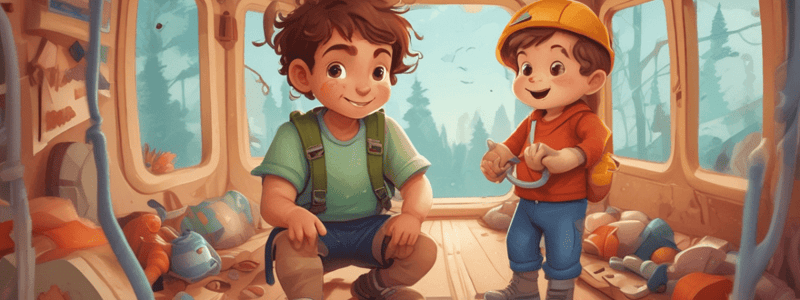Podcast
Questions and Answers
What is the primary purpose of risk in play, according to the content?
What is the primary purpose of risk in play, according to the content?
- To put children in dangerous situations
- To eliminate hazards in the environment
- To prevent children from getting hurt
- To allow children to test their own boundaries and limits (correct)
What is the difference between a risk and a hazard?
What is the difference between a risk and a hazard?
- A risk is something that can cause serious injury, while a hazard is something that is unlikely to cause harm
- A risk is something that can be eliminated, while a hazard is something that cannot be eliminated
- A risk is something that is always present in the environment, while a hazard is something that is temporary
- A risk is something that a child can see and test, while a hazard is something that a child cannot see (correct)
Why is it important to allow children to take risks in play?
Why is it important to allow children to take risks in play?
- So they can develop essential skills like self-reliance and problem-solving (correct)
- So they can learn to rely on others to solve their problems
- So they can develop a sense of fear and caution
- So they can become more dependent on adults
What is a key way to challenge children in play, according to the content?
What is a key way to challenge children in play, according to the content?
What is the ultimate outcome of allowing children to take risks and challenge themselves in play?
What is the ultimate outcome of allowing children to take risks and challenge themselves in play?
What is a benefit of outdoor play in terms of emotional well-being?
What is a benefit of outdoor play in terms of emotional well-being?
How does outdoor play contribute to physical health?
How does outdoor play contribute to physical health?
What is the role of outdoor environments in sensory development?
What is the role of outdoor environments in sensory development?
What is the significance of outdoor play in terms of environmental awareness and stewardship?
What is the significance of outdoor play in terms of environmental awareness and stewardship?
What is a key aspect of outdoor play in terms of cognitive development?
What is a key aspect of outdoor play in terms of cognitive development?
What is one way to increase physical activity in children?
What is one way to increase physical activity in children?
What is the term used in North Carolina to describe outdoor spaces in childcare centers?
What is the term used in North Carolina to describe outdoor spaces in childcare centers?
How can outdoor environments support children's learning and development?
How can outdoor environments support children's learning and development?
What is one benefit of outdoor play in terms of children's awareness of their bodies?
What is one benefit of outdoor play in terms of children's awareness of their bodies?
What is a key aspect of outdoor play that supports children's science learning?
What is a key aspect of outdoor play that supports children's science learning?
What skill do children develop when they make decisions without direct adult intervention in outdoor play?
What skill do children develop when they make decisions without direct adult intervention in outdoor play?
How does outdoor play contribute to the development of self-confidence in children?
How does outdoor play contribute to the development of self-confidence in children?
What type of learning is promoted when children are free to explore their interests in outdoor environments?
What type of learning is promoted when children are free to explore their interests in outdoor environments?
What is the primary motivation behind children's engagement in outdoor play when they are free to set their own goals and work towards achieving them?
What is the primary motivation behind children's engagement in outdoor play when they are free to set their own goals and work towards achieving them?
What is the role of adults in supporting children's autonomy in outdoor play?
What is the role of adults in supporting children's autonomy in outdoor play?
Flashcards are hidden until you start studying
Study Notes
Risk and Play
- Risk is a fundamental part of play, allowing children to test their boundaries and limits.
- Hazards are hidden dangers in the environment that can cause serious injury, whereas risks are challenges that children can see and navigate themselves.
- Removing all risk from play deprives children of the opportunity to learn how to do things for themselves and develop essential skills.
Supporting Children's Independence
- A nice way to challenge children is to ask them to try and do things for themselves, even if they're struggling.
- Instead of physically intervening, support them by talking them through the process and encouraging them to take control.
Benefits of Outdoor Play
Connection to Nature
- Regular outdoor play fosters a strong connection to the natural world, promoting environmental awareness and stewardship.
- Exposure to natural environments improves mental health and emotional well-being, reducing symptoms of anxiety and depression.
Physical Health
- Outdoor play contributes to physical health by encouraging physical activity and combating childhood obesity.
Sensory Development
- Outdoor environments provide rich sensory stimuli, enhancing sensory perception and contributing to the development of sensory processing skills.
- Outdoor play offers opportunities for sensory integration, helping children develop motor skills, balance, and coordination.
- Natural environments provide a range of sensory experiences, helping children learn to regulate their sensory needs and manage stress and emotions.
Conclusion
- The benefits of outdoor play extend beyond physical exercise, supporting holistic development, including cognitive, emotional, and social growth.
- It is essential to recognize the value of outdoor play and ensure that all children have access to natural environments where they can explore, learn, and grow.
The Importance of Outdoor Learning Environments for Children
- Outdoor environments can increase physical activity in children, as they tend to be more energetic when outdoors.
- Getting kids outdoors for long periods of time can lead to higher physical activity energy expenditure.
- Outdoor environments provide opportunities for children to engage with food cycles, promoting healthy choices and learning.
- Well-designed natural learning environments can encourage children to participate in the continuous food cycle, promoting awareness and engagement in learning and healthy choices.
North Carolina's New Approach to Outdoor Learning
- The language describing outdoor spaces in North Carolina has changed to reflect the richness of natural settings.
- "Outdoor Learning Environment" is now the official term used in North Carolina, acknowledging the outdoor environment as a serious educational resource.
Benefits of Outdoor Learning Environments
- Outdoor environments provide a space for children to learn, have fun, and develop physically, emotionally, and cognitively.
- Children's interests are encouraged in outdoor environments, allowing them to discover and pursue their passions.
- Spaces that eliminate the distinction between indoors and outdoors can be effective in promoting learning and play.
Physical Development in Outdoor Environments
- Outdoor environments provide diverse and complex spaces that afford incredible physical movement opportunities.
- Children develop body awareness and negotiate spaces with uneven terrain, rocks, and varying heights.
- Outdoor environments promote physical development in various ways, including movement, curiosity, and exploration.
Autonomy and Independence in Outdoor Play
- Outdoor play provides a safe space for children to make decisions without direct adult intervention, fostering decision-making skills and autonomy.
- Children develop problem-solving skills in outdoor environments, encouraging critical thinking and independence.
- Outdoor play builds self-confidence in children as they successfully navigate challenges and overcome obstacles.
Initiative and Intrinsic Motivation in Outdoor Play
- Outdoor environments are rich in opportunities for curiosity-driven learning, encouraging children to explore and investigate their interests.
- Children set and work towards achieving their own goals in outdoor play, teaching them about goal setting, perseverance, and achievement.
- Intrinsic motivation is fostered in outdoor play, as children are motivated by the activity itself, rather than external rewards or pressures.
Studying That Suits You
Use AI to generate personalized quizzes and flashcards to suit your learning preferences.



